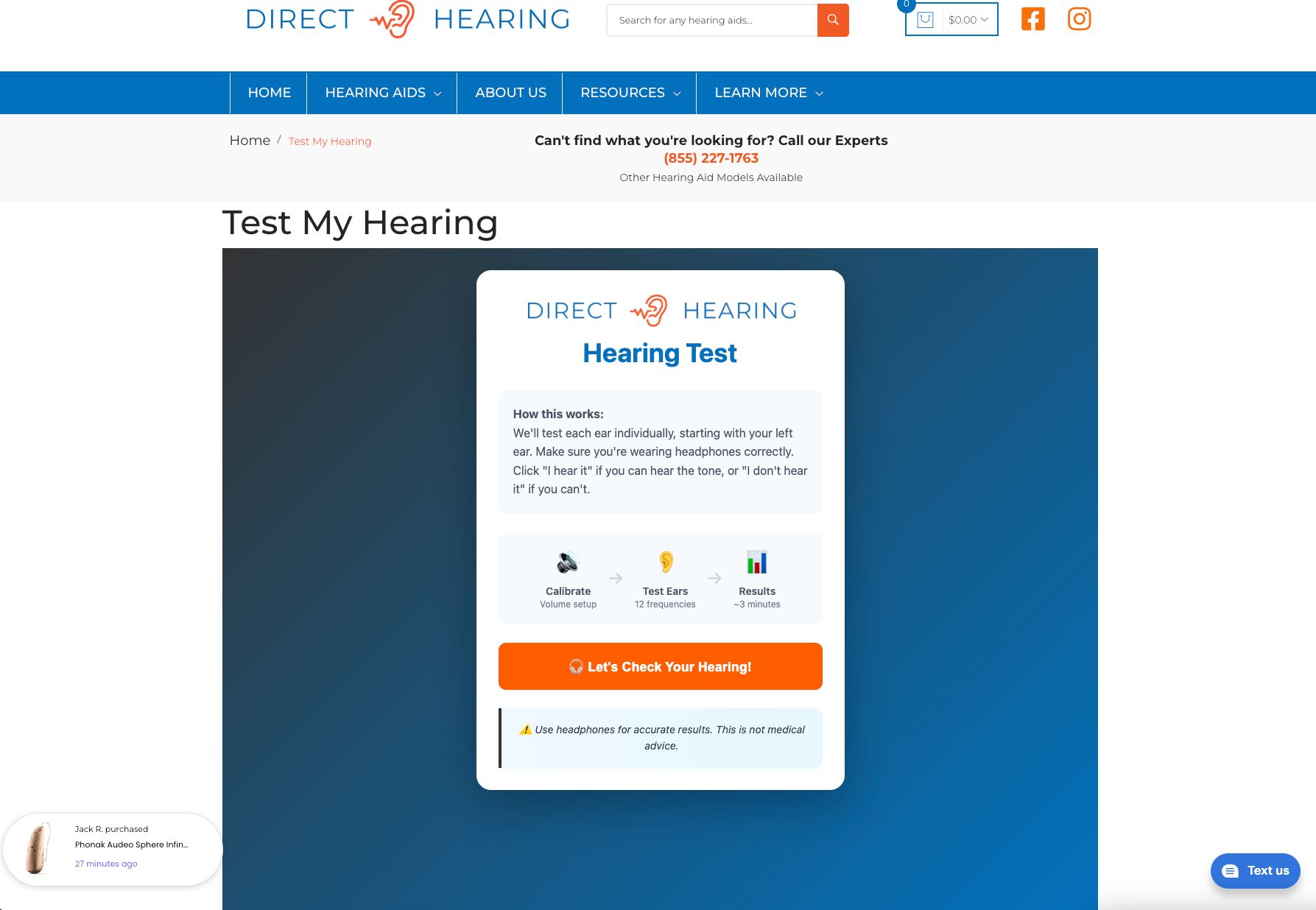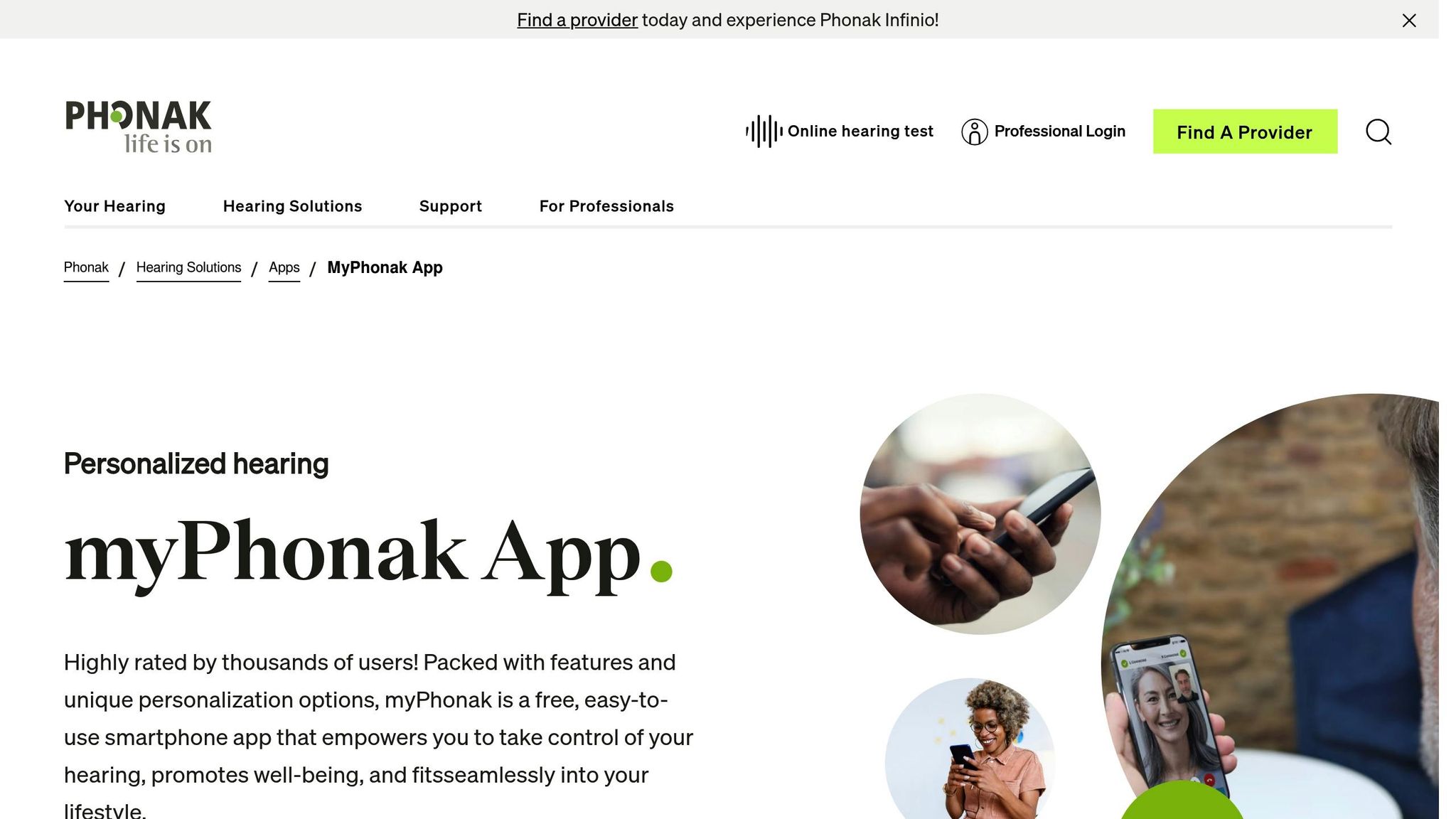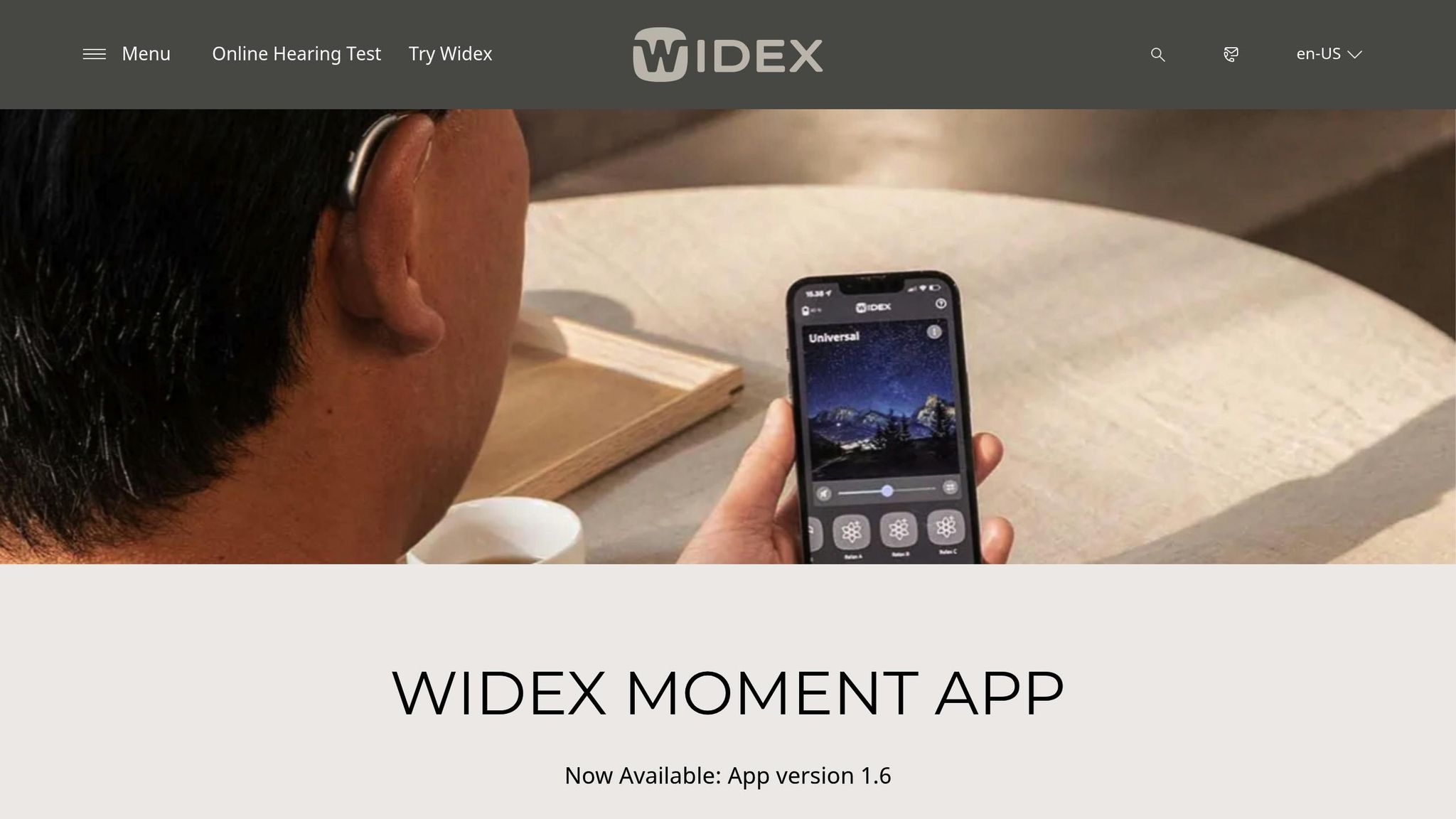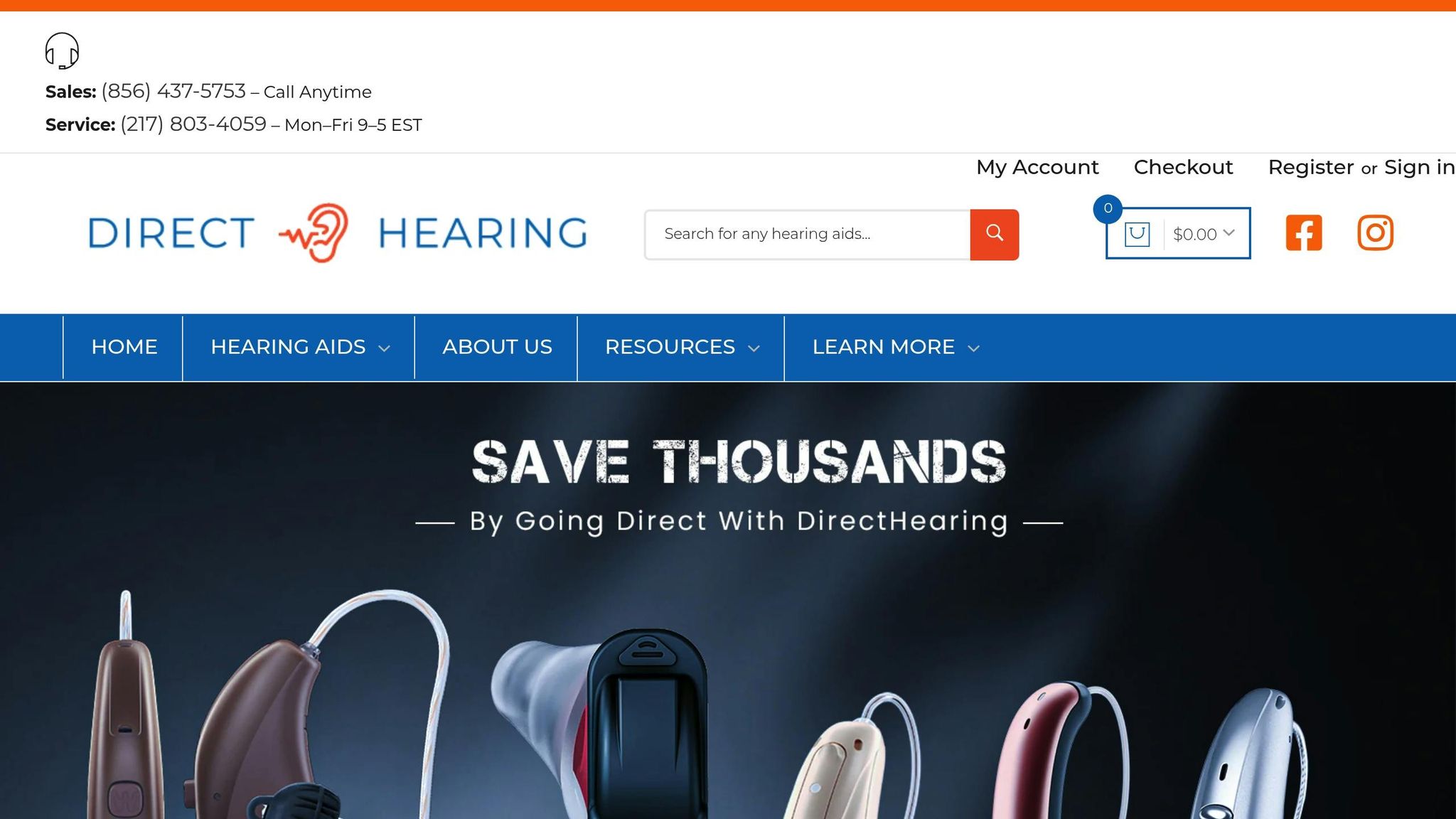
Phonak and Widex are two leading hearing aid brands offering remote programming capabilities, letting you adjust settings via smartphone apps. Here's a quick breakdown:
Key differences:
Quick Comparison Table:
| Feature | Phonak MyPhonak | Widex MOMENT |
|---|---|---|
| Setup | Single app | Multiple apps + device |
| Device Compatibility | Broad (iOS & Android) | Limited to newer devices |
| Customization | Noise cancellation, presets | AI-powered sound profiles |
| Professional Support | In-app sessions | Video calls via separate app |
Whether you prefer ease of use (Phonak) or advanced sound control (Widex), both brands offer strong options for remote hearing aid management.

Phonak has made a name for itself in the world of hearing care with its cutting-edge remote programming capabilities. By harnessing the power of its MyPhonak app, the company has set a high standard for remote adjustments, making hearing aid management more accessible and convenient.

The MyPhonak app is designed with ease of use in mind, offering a range of features that let users fine-tune their hearing aids directly from their smartphones. With the app, users can adjust volume, bass, treble, and noise reduction settings in real time. One standout feature is Remote Support, which allows audiologists to make professional adjustments remotely - no office visit required.
Thanks to universal Bluetooth compatibility, the app works with almost any device, including older Android phones and iPhones. Users can even stream audio from two devices at the same time, making it perfect for switching between, say, a phone call and a tablet. The app also offers personalized programs tailored to different environments, such as restaurants, outdoor spaces, or quiet settings. A hearing diary tracks daily usage and identifies situations where further fine-tuning might help.
For those managing tinnitus, the app includes built-in sound therapy tools with customizable relief sounds. This eliminates the need for separate apps or devices, integrating everything into one streamlined platform.
All these features come together to support a seamless remote programming process.
Phonak’s remote programming system is straightforward but requires a few essentials: a compatible smartphone, a stable internet connection, and Bluetooth-enabled hearing aids from Phonak’s current lineup, which includes the Paradise, Lumity, and Infinio models.
To start, users can initiate a Remote Support session through the MyPhonak app. This session provides the audiologist with real-time data on the hearing aid’s performance and current settings. While communicating directly through the app, the audiologist can make precise adjustments to the hearing aids on the spot.
Once changes are made, they’re automatically saved and can be updated later if needed. If a user’s hearing changes over time, prescription updates can also be handled remotely. Audiologists can upload new audiogram data and reprogram the hearing aids without requiring an in-person appointment.
Phonak offers several advantages that make its remote programming features stand out.
That said, there are a few challenges to keep in mind. The app’s reliance on Bluetooth can drain a smartphone’s battery during extended use. For those less comfortable with technology, the initial setup - including pairing hearing aids and configuring Bluetooth settings - might feel overwhelming and require help from family or a hearing care professional.
Additionally, while the remote support scheduling system is convenient, it may have limited availability during peak times. Users in rural areas might face longer wait times for remote sessions compared to those in urban locations.
Widex takes a unique approach to remote programming, offering a system designed for precision, albeit with a slightly more involved setup compared to others like Phonak. At the heart of their system is the WIDEX REMOTE CARE™ system, which works in tandem with the Widex MOMENT app. While the system delivers professional-grade remote adjustments, it requires additional components, adding a layer of complexity. Let’s dive into the app’s features and the step-by-step process for remote adjustments.

The Widex MOMENT app is the central hub for users to manage their hearing aids, packed with personalization options to suit individual needs. One standout feature is the personal sound profile assistant, which helps users tailor their hearing experience based on specific listening environments.
With the app, users can adjust volume, switch between hearing programs, and fine-tune sound settings - all from their smartphone. It even includes a “Find My Hearing Aids” tool to help locate lost devices. The app is compatible with popular iPhone and Android models, ensuring broad accessibility.
What sets the app apart is its ability to create and save custom sound profiles for various settings, whether you’re dining in a noisy restaurant, enjoying the outdoors, or relaxing in a quiet space. Over time, the app learns user preferences and offers adjustment suggestions. However, for professional-level remote programming, users need to download an additional app, WIDEX REMOTE CARE, which is specifically designed for remote sessions with hearing care professionals.
Widex’s remote adjustment process ensures personalized care, but it does require a few extra steps. To get started, users need a compatible smartphone, the WIDEX REMOTE CARE app, and a WIDEX REMOTE LINK device.
Before the session, it’s important to charge all devices and connect to a reliable Wi-Fi network. To activate the WIDEX REMOTE LINK device, press its button for five seconds until the blue light flashes, signaling it’s ready to pair with your smartphone via Bluetooth. This device acts as a bridge, connecting your hearing aids to the professional’s software.
When it’s time for the scheduled session, users join via the REMOTE CARE app, which establishes a real-time video connection with their hearing care provider. Using the Compass GPS software, the audiologist connects to the hearing aids through the REMOTE LINK device and makes the necessary adjustments.
Once changes are made, users receive a notification to confirm the new settings. They can test the adjustments immediately and provide feedback in real time. If the new settings aren’t satisfactory, further tweaks can usually be made during the same session.
Widex’s system offers a mix of benefits and challenges. The personal sound profile assistant is well-regarded for adapting to user preferences, while the remote programming feature, complete with a live video connection, allows for convenient follow-up care and adjustments without visiting a clinic. This flexibility is particularly helpful during trial periods or for ongoing support.
However, the setup can feel daunting. Managing multiple components - the MOMENT app, the separate REMOTE CARE app, and the physical REMOTE LINK device - can be a bit much, especially for those less tech-savvy. Some users also find the interface less user-friendly, particularly when switching between apps. Additionally, compatibility with specific smartphone operating systems means that users with older devices might not be able to access all the remote programming features. While the system offers advanced functionality, the added complexity may not be ideal for everyone.
Looking at the features side by side, it's clear that Phonak and Widex take different approaches to usability and setup, especially when it comes to remote programming. Both brands deliver high-quality remote adjustments, but their methods are tailored to distinct user preferences and needs.
Phonak keeps things straightforward with its MyPhonak app, which integrates every aspect of remote programming into a single platform. According to research, 75% of Phonak Infinio users appreciate the app for personalizing their listening experience. On the other hand, Widex requires a separate REMOTE CARE app and an additional accessory, offering advanced sound customization with features like AI-powered MySound profiles and SoundSense Learn.
| Feature | Phonak MyPhonak | Widex MOMENT |
|---|---|---|
| Remote Programming Setup | Single app integration | Separate REMOTE CARE app + REMOTE LINK device |
| App Usability | Simplified pairing, clear labels | Step-by-step guidance with My Guide |
| Device Compatibility | Broad smartphone support | Limited by specific OS requirements |
| Key Customization Features | Dynamic noise cancellation, speech focus | AI-driven MySound profiles, SoundSense Learn |
| Health Tracking | Tracks steps, heart rate, wearing time | Not available |
| Find My Hearing Aid | Available (rated highly by 81% of pros) | Available |
| Interface Design | Optional Dark Mode, quick widgets | Constant Dark Mode for discretion |
| Professional Support | In-app remote sessions | Video calls via separate app |
| Learning Capabilities | Basic preference tracking | Advanced AI-driven recommendations |
| Setup Complexity | Low – single app solution | High – multiple apps and devices required |
This table highlights the differences in everyday usability and setup, with Phonak focusing on simplicity and Widex prioritizing advanced sound customization.
Phonak stands out with features like widgets for quick adjustments on both iOS and Android. Users can tweak volume, switch programs, or mute their hearing aids without fully opening the app. Widex, however, requires navigating between its apps depending on whether you need basic adjustments or professional support.
When it comes to sound personalization, Widex shines. Its MySound feature uses AI to recommend tailored profiles, while SoundSense Learn adapts to user behavior over time. Phonak, meanwhile, emphasizes practical adjustments like dynamic noise cancellation and speech focus, which are particularly useful in everyday environments.
The professional support experience also differs. Phonak allows hearing care providers to access devices directly through the MyPhonak app, making remote sessions seamless. Widex, however, requires users to schedule sessions through its REMOTE CARE app, which includes real-time video calls for a more personal touch.
Setup and technical requirements are another dividing line. Phonak users can complete their first remote session within minutes of downloading the app, while Widex users need to manage multiple components, ensuring everything is charged and properly connected before each session.
These differences in usability and setup should help you decide which system aligns better with your technical comfort level and need for customization.
When it comes to remote programming systems, the ultimate measure of success lies in how smoothly they function in everyday use and the kind of support users receive when things go wrong. Phonak and Widex have each built support systems that reflect their unique philosophies on user care. This practical difference plays a significant role in shaping user experiences and the effectiveness of their assistance.
User feedback paints a clear picture of how people interact with the remote programming features of these two brands. Phonak users frequently highlight the ease of using the MyPhonak app. Its straightforward design and the ability to quickly connect with hearing care professionals for real-time adjustments make resolving issues much simpler and faster.
On the other hand, Widex users often mention that the setup process can be more complicated. The need for a second app and a neck loop adds extra steps, which some find frustrating. While some users eventually appreciate the advanced customization options once they get the hang of the system, others struggle with the initial learning curve.
The quality of support becomes crucial when technical problems arise, and this is where the differences between the two brands become even more apparent. Reliable support is essential for remote programming to work effectively, and each brand approaches this in its own way.
Phonak offers a centralized support system that includes an online FAQ, a toll-free 1-800 number, and an online contact form. What sets Phonak apart is the integration of remote programming support directly into the MyPhonak app. This allows users to connect seamlessly with hearing care professionals for adjustments and consultations. Additionally, Phonak provides insurance options for its devices, which adds an extra layer of reassurance for users.
Widex, in contrast, takes a more fragmented approach to support. Assistance is available through online video tutorials, in-app guidance, and local repair services. However, Widex's remote programming setup, which requires a second app and a neck loop, can lead to troubleshooting across multiple components. Moreover, Widex's warranty applies only to devices purchased through authorized distributors, which may limit coverage depending on where the product was bought.
The difference in support strategies becomes particularly evident during technical challenges. Phonak users benefit from a single, integrated support channel, making issue resolution more straightforward. Widex users, however, may need to navigate a more complex system, which can require specialized technical knowledge from service providers. While both brands offer local repair services, Widex's more intricate setup often demands additional effort to resolve issues effectively.

Direct Hearing has made it easier than ever to get your hands on Phonak and Widex hearing aids. By cutting out unnecessary hurdles and costs, they’ve streamlined the process, making advanced hearing technology more accessible for customers in the U.S. This approach ties in seamlessly with the remote programming features we’ve discussed earlier.
Beyond offering competitive pricing, Direct Hearing provides a personalized experience. They feature a range of Widex models, including the Widex SmartRIC 440 priced at $1,040.00, the Widex Moment Sheer 440 at $1,042.50 (down from $1,558.00), and the Widex Allure 440 R D for $1,834.00. For Phonak models like the Audeo Sphere Infinio I90 and Audeo Lumity L90, pricing is provided over the phone due to Phonak's advertising policies. These prices often save customers thousands compared to traditional hearing aid dispensers.
"Buying Direct is fast, easy, and affordable. We have removed the middle man to bring you direct service at a fraction of the cost." – Direct Hearing
With over 30 years of experience, Direct Hearing helps customers select and program their devices with ease. You can submit your hearing test online or complete a quick assessment, and your customized devices will arrive in 7 to 14 business days. For Phonak users, this includes models like the Audeo Lumity L90, which supports remote programming on a global scale.
Direct Hearing also provides robust remote programming services. This includes real-time adjustments by specialists, handling warranty claims, repairs, troubleshooting, and virtual hearing care - all through one centralized service. This eliminates the need to juggle multiple service providers when you need assistance.
To give customers peace of mind, Direct Hearing offers a 60-day risk-free trial with a full money-back guarantee on all purchases. They also provide financing options, making premium hearing aids more affordable.
Customer reviews frequently mention fast delivery, fair pricing, and outstanding customer support. These elements highlight how Direct Hearing simplifies the experience for those using advanced hearing aids.
For U.S. customers exploring the remote programming capabilities of Phonak and Widex, Direct Hearing not only provides access to these brands but also delivers the expertise and ongoing support needed for a smooth, hassle-free experience. Their approach ensures you can make the most of cutting-edge hearing technology.
Phonak's MyPhonak app stands out with its ability to provide instant adjustments and global accessibility - perfect for those who are always on the move. On the other hand, Widex's MOMENT app uses AI-driven personalization to fine-tune sound settings, offering a tailored listening experience.
Both brands have revolutionized hearing aid management by removing the need for in-person appointments. Now, users can enjoy remote adjustments that adapt as their hearing needs change.
Direct Hearing takes these innovations a step further by making access to these technologies seamless. Their expertise with both Phonak and Widex devices, combined with robust remote programming support and competitive pricing, makes managing premium hearing aids easier than ever. Plus, the 60-day risk-free trial gives you the chance to explore these remote programming features without any financial stress.
Whether you’re drawn to the global remote programming of Phonak’s Audéo Lumity L90 or the AI-powered customization of Widex models, Direct Hearing provides the support you need to make an informed choice. With their guidance, you can experience clear, personalized hearing - all without stepping into a clinic.
Phonak and Widex both offer remote programming options, but their setup processes differ slightly due to variations in their app designs and connectivity features. Phonak relies on the myPhonak app, which connects hearing aids to your smartphone via Bluetooth, enabling your audiologist to make remote adjustments. Widex takes a similar approach with its Widex Moment app, also Bluetooth-enabled, allowing for remote programming customized to your preferences.
While both brands strive to simplify the setup experience, the exact steps can vary depending on the model and type of hearing aid you’re using. For the best results, check the user manual included with your device or reach out to a professional. Experts, like those at Direct Hearing, are available to help with setup and ensure your hearing aids are tailored to your needs.
The MyPhonak app simplifies managing your hearing aids by letting you adjust settings like volume, programs, and sound preferences directly from your smartphone. Its straightforward design ensures you can make quick tweaks for daily use or handle more detailed adjustments with ease.
Beyond basic controls, the app includes helpful tools like hearing diaries to track your preferences and remote updates to keep your devices performing at their best. This personalized approach ensures your hearing aids adapt to your lifestyle, making your listening experience more comfortable and tailored to your needs.
Many people opt for Widex’s AI-powered sound customization because it offers a deeply personalized hearing experience. By leveraging advanced AI technology, the system evaluates real-world soundscapes and individual preferences to create sound profiles that adjust to each person's needs in real time.
Although the setup process can be a bit more involved, the payoff is worth it. Users frequently describe the hearing experience as more natural and immersive, tailored to seamlessly fit into their daily routines. This makes it a popular option for those looking for cutting-edge sound adjustment.